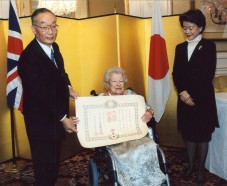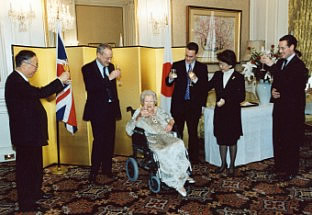On December 10, The Order of the Rising Sun, Gold Rays with Neck Ribbon, was presented to Lady Sainsbury in recognition of her tireless endeavours and great contribution to the field of research into Japanese art, including the collection and preservation of Japanese works, and the role she has played in artistic and cultural exchange between Japan and the UK.
Together with her late husband Sir Robert Sainsbury, who transformed his father's grocery store into the famous British supermarket chain, and who passed away in 2000, Lady Sainsbury made an immense contribution to the world of art, for instance through the African Art Gallery she and Sir Robert established at the British Museum.
|
 |
|
From the 1960s onwards Lady Sainsbury devoted herself to collecting Japanese works of art and did much to bring about the introduction and study of Japanese culture, centred on art and archaeology, in the UK. In particular, with her late husband Sir Robert, she set up the Sainsbury Institute in Norwich in 1999, to which she added a library in 2003. Academic exchange between the Institute and Japan has flourished through the Institute's regular acceptance of research fellows from Japan and its nurturing of young researchers in Japanese art and archaeology.
|
Lady Sainsbury is toasted by Ambassador and Madame Orita, her son Lord Sainsbury
(Parliamentary Undersecretary for Science and Innovation) and her grandsons. |
 |
Speech delivered by Ambassador Orita at the award ceremony:
Lady Sainsbury, Distinguished Guests, Ladies and Gentlemen,
It is my greatest honour and pleasure to bestow upon Lady Sainsbury, on behalf of His Majesty the Emperor of Japan, the Order of the Rising Sun, Gold Rays with Neck Ribbon for her lifelong contribution to the promotion of Japanese culture in the United Kingdom and of better understanding between the peoples of our two countries.
It is interesting to ponder how people become attracted to something. We may fall in love with someone at first sight and remain so for the rest of our lives. This happened to Dante when he first saw Beatrice in Firenze. He was nine years old at the time. Or it could well be that someone who was as anyone else among millions, gradually become so indispensable in our lives.
From the Japanese perspective, Lady Sainsbury's encounter with a piece of Japanese art, Negoro-nuri, one day in the early 1960's, in Manhattan, New York, proved to be a blessing from the heaven. It was the era when a sample of Japanese art could have been appreciated by only a small number of Japan specialists in the Western World. Nonetheless, Lady Sainsbury and her late husband Sir Robert were enraptured by Japanese art and never stopped enriching their collection. Today, thanks to their endeavours, we can see Japanese masterpieces 'rubbing shoulders' with superb works from myriad other cultures in the spacious display of the Sainsbury Centre for Visual Arts in Norwich.
The achievements of the Centre, which celebrated its 25th anniversary this year, are already well known. It is fair to say that, without the passion - in the most noble sense of the term - of Lady Sainsbury and the late Sir Robert, this facility would not have come about. It is a veritable blessing for all of us that the Sainsbury Centre for Visual Arts houses such a magnificent collection. The works are ready for the citizens of Norwich and far beyond to savour. Long may this situation continue.
The devotion of the Sainsburys to Japanese culture does not stop there. In yet another extraordinary move, the Sainsburys sold their Modigliani work, Portrait of Baranowski to fund the establishment of the Sainsbury Institute for the Study of Japanese Arts and Cultures in 1999. The Institute is still young but, under the directorship of Nicole Rousmaniere, is quickly becoming one of the most vibrant centres of Japanese culture in the United Kingdom. Affiliated with the University of East Anglia and operating in association with the School of Oriental and African Studies (SOAS), University of London, the Institute is home to a number of researchers who are producing excellent results. It also organises lectures related to Japanese arts and culture which are always well attended, and is forging strong working relations with such institutions as the British Museum - and, indeed, the Embassy of Japan.
I recall with pleasure the occasion in May of this year when I had the greatest honour of officially opening The Lisa Sainsbury Library at the Institute. Devoted to works on Japanese arts, culture and archaeology, the Library currently holds some 20,000 volumes and is adding to its catalogue every day. A number of eminent people have made substantial and generous donations of books to the Library - including Sir Hugh Cortazzi, who is with us today.
It is also a joy to see Dame Elizabeth Esteve-Coll on the Board of Trustees of the Institute. Japan has enjoyed a close working relationship with her over the years, in particular when she was the Director of the Victoria and Albert Museum. The exhibitions Visions of Japan, organised at the time of the Japan Festival of 1991, and Japanese Studio Craft: Traditional and the Avant-Garde, put on in 1995, are cases in point. She also worked hard, as Vice Chancellor of the University of East Anglia, to forge strong ties between the University and its counterparts in Japan.
Last but not least, Lady Sainsbury inspires us all with the precious lesson of life and how to live it to the full. She may be 91, 30 years older than me, but she always takes an initiative! She teaches us that it is ultimately a youthful spirit that keeps us young. At the same time, respect for one's seniors comes naturally to the Japanese. In this sense, therefore, we salute you Lady Sainsbury and offer you our warmest good wishes for the future.
With these remarks, may I now bestow upon Lady Sainsbury the Order of the Rising Sun, Gold Rays with Neck Ribbon.
Thank you. |


